

Computer in science, like their rather sedater colleagues in industry, call up strongly ambivalent reactions among the general public. Too much is expected of them; at the same time they are more feared than is necessary, and for the wrong reasons. Computers sometimes do seem to go wild and frivolous in the hands of academics. Chess games and balancing acts, economic models to play with the country's economy as if it were a toy train, surveys and health records; spewing out all sorts of facts hitherto considered the confidence of the family doctor or social worker - these are the visions which create doubt.
To get some idea of what is going on in universities' computer bureaux and of what it is like to work with a computer doing creative scientific work, I visited several universities. One of them I looked at more closely, and then finally spent some time with the Atlas laboratory at Chilton, Berkshire, where many of the big scientific jobs which do not fit into smaller slower computers are sent.
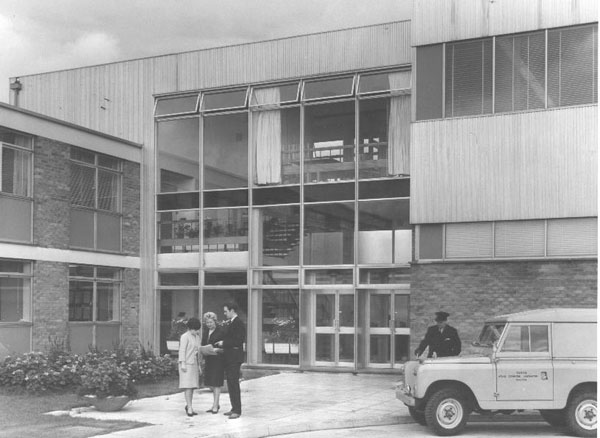
It would be a monumental task, beyond the scope of this book, to cover even briefly all that universities and technical colleges are doing with computers; it would mean in effect an index of all current research that is subject to quantifying methods. But putting aside the jungle of new disciplines like information science, study of data and automata, machine intelligence, I found that there were certain trends in the computer side of science that are interesting to the rest of us.
. . .
The users of Atlas (i.e. the people in universities and other research groups who need the fastest computation time and largest store because they have the biggest jobs) are still predominantly physical scientists, but the social sciences - well-known figures in economics and medical-social research among them - are increasing their proportion of Atlas time vastly. It is in this field that work which would have been out of the question in pre-computer days is now beginning to get done. Work can also be done better: a survey which can play off every factor measured against every other is far more fair and accurate than one which compiles only whatever tables the research director has decided are worthwhile.
True, certain sciences have received a terrific boost through this technological revolution. The people who work out the structures of molecules - crystallographers - have a whole program to themselves evolved at Atlas, and frequently tie up a programmer to work with them.
. . .
The Science Research Council's Atlas Computer Lab, attached geographically to the Harwell complex of scientific establishments, works round the clock and processes from 400 to 500 programs on each day-shift alone. The scale of operation there is so massive that it is worth examining in detail. the Atlas bureau has grown at a typical computer pace: slow at first, then in a rush. It was established in 1961 to serve both Harwell's atomic energy research needs and those of the Rutherford High energy lab nearby, with the idea that it would also be useful for university research and build itself up as a computer bureau. Originally the time was divided equally three ways: Harwell, Rutherford and universities; now universities take 60-70 per cent, and many others get a share. the Atlas I computer (made by Ferranti, since taken over by ICL) was installed in April 1964 and soon began an eight-hour daily shift. (The only other Atlas Is in the country are at London and Manchester.)
When the Science Research Council was set up in 1965 it took over Atlas. The present chain of command for acquiring financial approval of anything Atlas does looks rather like a Smith family tree. from the Treasury, the responsibility for Atlas descends via the Department of education and science, the Science research Council and the University Science and Technology Board. Along another branch via the Ministry of Technology, Atlas is influenced by the Computer Board and finally it has its own committees of eminent personages to whom papers are written when something needs doing.
All this extended family relationship is kept up by the lab's gregarious extrovert Director, Jack Howlett. He came from Harwell to build Atlas up from its 1961 beginnings and his personality sets the atmosphere of this remarkable institution.
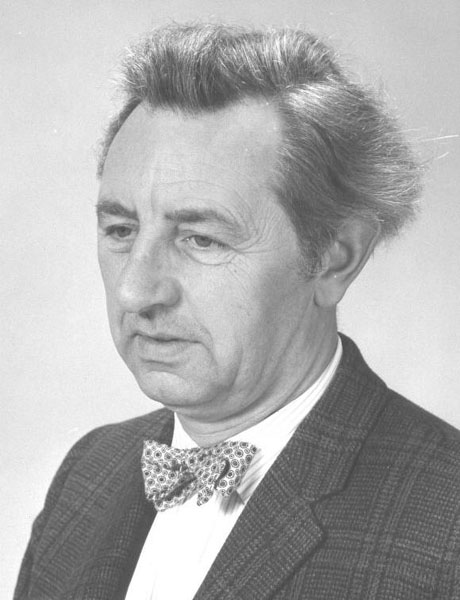
Without the help of the computer, Dr Howlett makes such decisions as what to buy next and when to buy it, writes papers outlining the possibilities and his recommendations for the various boards. The first machine, ordered in 1961 cost £2,800,000, and the scale is ever-increasing although prices per unit are coming down. It has been added to each year, with a satellite computer arriving in 1968. Computers only last about seven years at top form. The day the present Atlas started work, they handed in their formal estimates for a new machine, which only now, nearly four years later, is coming to the point an actual order - such is the pace of the hardware growth.
Here are the various pieces of actual machinery that go to make up the Atlas installation, the largest in the country and one of the largest in the world:
The Atlas Central processor and storage: with 48,000+ words of binary digits each, in what is called the core store, and 96,000+ word magnetic drum store, plus 8,000+ word fixed store in which basic routines (instructions) are stored, and 16,000+ word working store for these routines.
The Sigma 2 satellite computer with 32,000+ words of 16 BITS but with certain restrictions on how many may be used for what. This is used for multi-access system, in other words for scientists plugging directly into Sigma 2, which then passes on the processing work to Atlas and deals with the output as and when it comes from Atlas.
A disc file of 16,000,000 words for extra storage: used for the operating systems including the all-important Supervisor which manages the work once it is fed into the computer. this also provides the necessary storage space for the multi-access system.
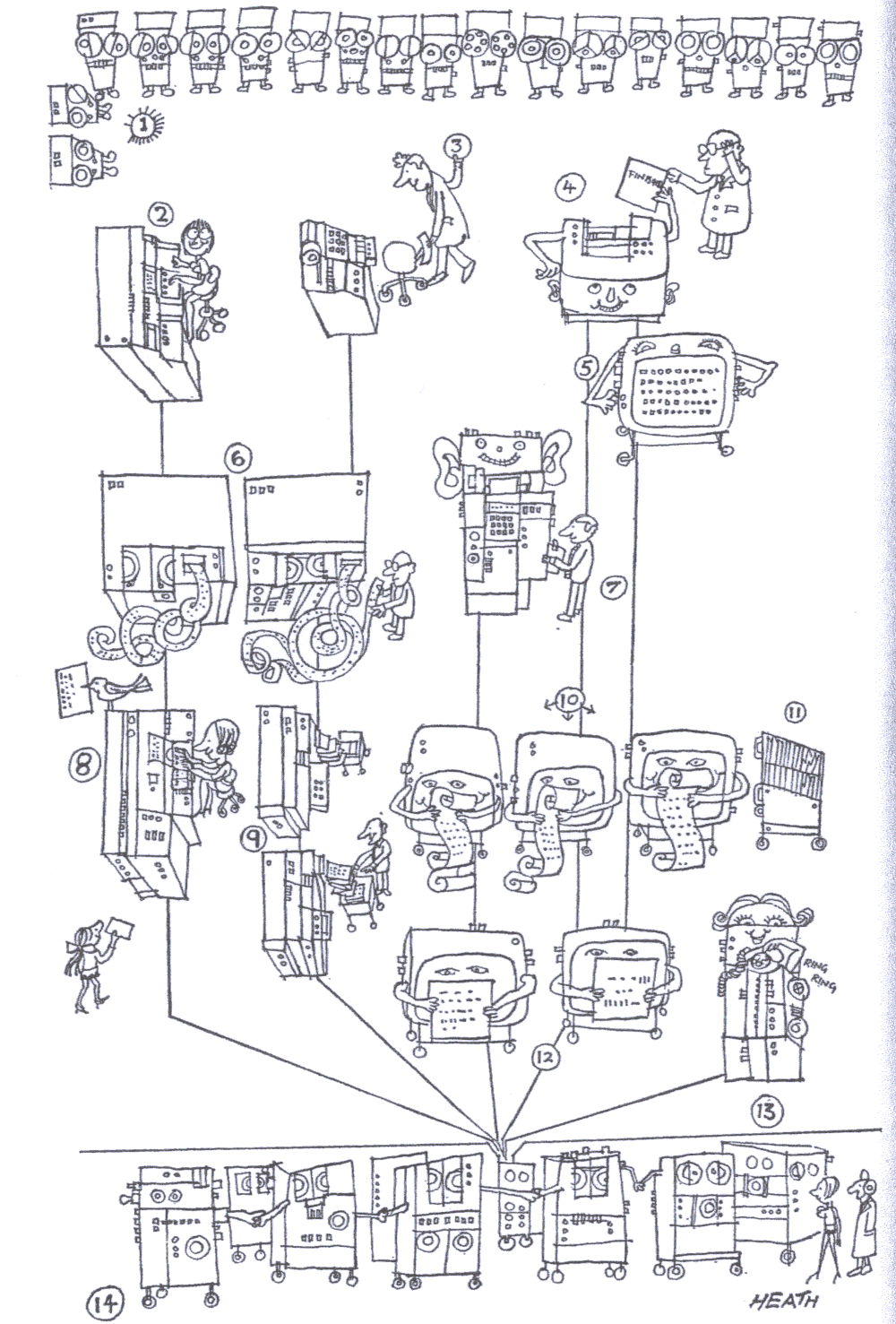
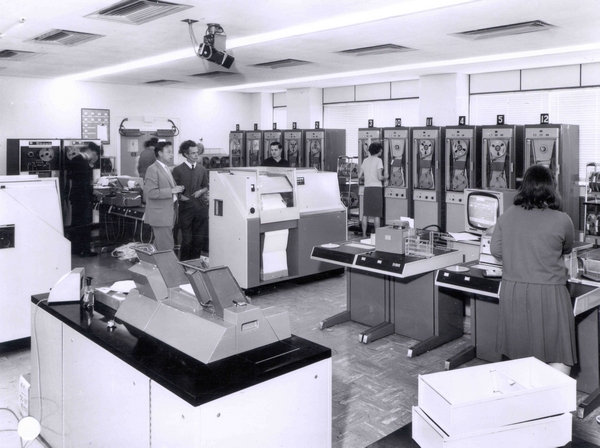
The peripheral equipment (i.e. the machines which either read information into the computer, or write information out of it): eighteen magnetic tape decks; two card readers, three paper tape readers, two printers, one card punch and two paper tape punches. There is also a microfilm graph plotter for automatic drawings of graphs from magnetic tape, and three typewriter controls, a logger and the new consoles for users outside the computer room (sixteen of these) (see drawing).
Atlas is a non-profit making organization, but does a paper exercise in accounting. The cost of running the machine is reckoned at £200 per hour, or roughly a shilling a second, and non-university users actually pay that amount. The universities are given a weekly account, but they don't pay it. Commercial rates for an equivalent service would be about £350 per hour.
The staff quota grew at a more leisurely pace than the machinery. Professional staff comes easily and the lab has a good reputation among research students who come and go as programmer assistants. Operations staff is a bit more difficult as the pay offered is not as high as commercial rates and yet the operating staff has a lot of responsibility. The turnover on both scientific and operating sides is fairly large, but Dr Howlett believes that one of the lab's functions is training personnel, so he suffers this.
The staff of the Atlas lab, now about 100, should continue to increase slowly as the machinery increases. But when the new disc file and satellite computer were added early in 1968, no new people were employed, a fact which is more a measure of increasing efficiency than an indication that the organization is static.
But the striking thing about the Atlas staff is not its size or what it does as much as its extraordinary openness and, as someone put it, the flatness of the hierarchy. It is certainly neither a civil service nor an academic quality to have staff of all levels on first-name basis, having weekly tea and daily coffee together and attending lectures regularly together. This is a product partly of the nature of the work: the machine demands communication between all the people dealing with it for maximum performance, and partly because Dr Howlett saw from the beginning that informal team-work would do the job better.
Card punch operators are given time off to attend lectures about
archaeology by a resident scientific research officer; employees taking
coffee in the common room and lunch in the Rutherford lab's
restaurant are well mixed, although the data preparation girls do
admit to finding it something of an effort at times. As Dr Howlett
puts it, The presence of research activities in the building and easy
contacts with the academic world and with other computing centres
are essential to the intellectual health of the members of the Laboratory
. His secretary, Synolda Butler, described the lack of formality
even more succinctly, Everybody is anxious to get the work done
.
It is a community thrown together by its speciality, too. Many of
the people I talked to here as at other computer installations voiced
a sense of isolation as a result of their work. People haven't the
foggiest idea what it is all about
, is the usual complaint. hence they
club together a bit more where they can talk the same language.
During the period of several months when I visited the lab, at least
two engagements ripened in the machine room - but that probably
had more to do with age group of employees than anything else.
When I first visited Atlas, a new wing was being hammered away at one end of the building - a rather nondescript functional structure from the outside - set among the wide open spaces of that extraordinary city of scientific buildings on the edge of the Berkshire Downs. Inside, it could hardly have been less like a civil service establishment: good modern design, open friendly efficiency, marley tiles and indoor plants. Before long, one inevitably noticed the pictures on the walls - well-made reproductions of a Picasso here, a Leger there, two Kandinskys in data prep - all chosen by Dr Howlett.
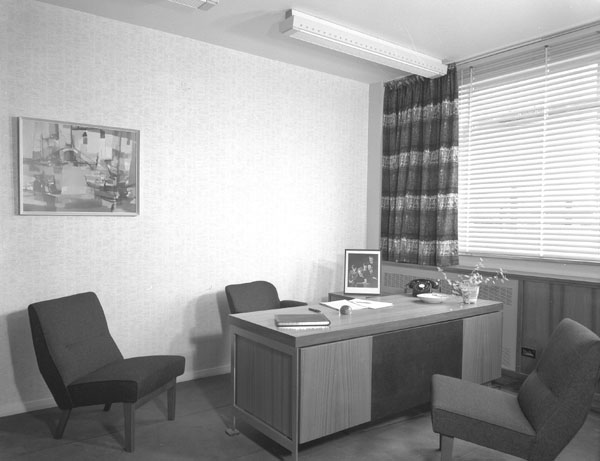
More like a new university than anything else, Atlas provides comfortable cells for each of its resident and non-resident researchers and a glass-walled think room for any overflow ( nearly always full). Every office I went into had a blackboard, most often filled with rather daunting mathematical formulae. the thinking part of the structure trails off like a U-shaped tail from the computer block itself where the hardware lives. Atlas's innermost storage and processors are never seen by either visitors or residents: they are stored away in an air-conditioned, rat-proof, fire-proof room on the ground floor, while all the operating is done on the floor above in a giant (by commercial standards) machine room.
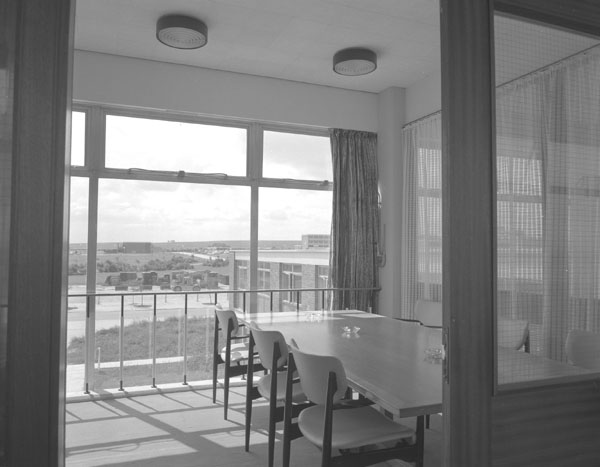
It is very much part of Dr Howlett's philosophy that a bureau dealing with such efficiency as a computer provides must be run equally efficiently. this feeling pervades every level: it would be pretty ridiculous to employ a machine that works in microseconds and let the material that goes in and out lie about for days or get mixed up in transit. Arrivals and departures of visitors and users are just as important - the people who ask the computer questions have to be processed as agreeably as the material.
To handle all these functional details, Atlas found an ex-Eighth Army
sergeant-major, C L Roberts, and it was he who showed me
around the physical plant. I quickly began to understand the admiring
awe with which the scientific staff spoke of Mr Roberts -
If you need steam in a certain room, you get steam.
When we move, which we frequently do, we find our old telephone numbers in residence
before we are
, said one.
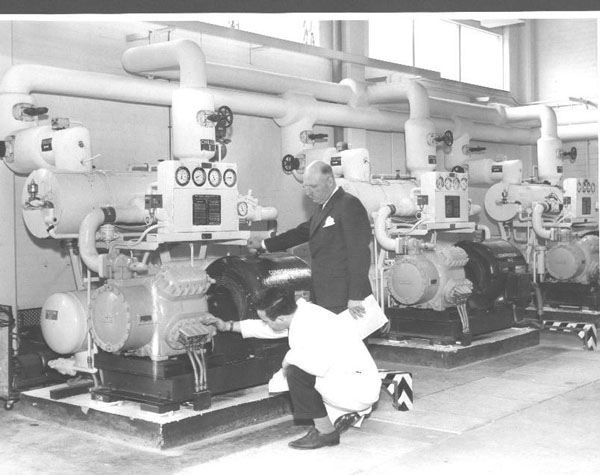
First Mr Roberts showed me the fire prevention system - made doubly necessary in computer rooms because of the heat computers generate and the inflammability of anything electrical. If you stand too near one of the fire detectors with a cigarette the fire department arrives from Harwell. When they get there, the firemen find at the entrance to the computer room itself, a coded diagram which would automatically light up in the area where the fire is. they have arrived twice in Atlas history - total damage, two resistors costing 1s. 6d. each.
The metal cabinets containing the electronic materials are bugged with smoke detectors in case a resistor heats up. Smoke detectors are hidden in the air conditioning plant which changes 25% of the air every hour. Along the corridors of Atlas's storage room which looked more like a basement locker room than anything else, Mr Roberts demonstrated the false floor which prevents damp and rats; in a large separate area he showed me proudly the three compressors and the water tank for the air conditioning system - patently failsafe.
Aside from seeing to all this equipment which the nature of the
computer requires, Mr Roberts feeds the computer its regular supplies
of paper - tons of it a week in tapes, cards, and print-out paper -
and deals with its accounts (just one clerk and the computer do the
accounting). We do everything that the other people don't want to do
,
said Mr Roberts with relish.
I've got a letter on my desk now, two employees don't want it known they are getting married and I've
got to get them some buckshee leave without telling anyone
.
His staff include a deputy, three clerks, a librarian, two clerical
assistants, two typists, two drivers and four cleaners (very important
- If the place is not kept clean the machine packs up with dirt
).
Mr Roberts has infected them all with his own passionate conviction
that This is the thing that matters: that machine
. among the items
they have to deal with are ribbons for the high speed printers which
need changing twice a week at £181 for twenty; magnetic tapes at £34
which are ordered 100 at a time (the library has about 1,500 of
these already on tap); millions of sheets of printer paper are kept on
hand and there are cards, cards, cards: Fortran cards, binary cards,
job description cards, 10,000 cards to a box, 45 boxes or so a month.
And the cards have to be kept very carefully because the card readers
are so choosy. If cards are bent or dirty or damp they do not read.
They are now sent by road because they got bashed about on the
railway, then they are kept in air-conditioned storerooms, turned
over frequently and issued in strict order by date received.
Mr Roberts enthusiasm for these details knows no bounds.
He considers himself one of the world's lucky men.
His two chief interests in
life are accounting and fire brigades; he comes to work at all hours,
sometimes Sundays and said,
All this is a hobby of mine, I admit it freely
.
Returning to the upper floors again, it is easy to be carried off by the atmosphere of intellectual energy. Think says the sign in seven languages. Atlas's thinkers come in three departments: operators, programmers and research scientists.
The research scientists, who often have a fellowship at a university and share their time between the two, do their own independent work, using the facilities of Atlas. Very often in the course of their work they develop new mathematical techniques for putting research on the computer and these are available for others in the field. This way, Atlas benefits from giving them the facilities. Some of the research students are doing mathematical work with abstruse titles such as: Solutions of the Relativistic Hartree-Fock Equations, or Computing, Partitions and Thirteen which has to do with number theory. One, Dr I P Grant has been developing ways of putting observations from the planet Venus into mathematical models. Another rather off-beat research scientist has been the archaeologist, Dr Frank Hodson of both Cambridge and London Universities. He has spent about a year and a half there off and on working out a system of archaeological classification using the computer.
Another set of cell-like offices at the Atlas lab is occupied by the program staff, mostly two to a cell. under the supervision of Dr R F C Churchhouse, this group is made up of mathematicians, helped by occasional students with open scholarships waiting for places at university or taking sandwich courses. Gradually two groups have evolved, those who are developing new programs and new systems of programs, and those who help users with programming problems - consisting of programmers and operational people working together in a newly formed support group.
To get an idea of the depth of the scientific problems being solved in detail at Atlas, I talked at length with the program staff about specific projects they were working on. One of the longest resident program developers is B E Cooper, who has worked out a set of programs called ASCOP, or A Statistical Computing Procedure. This very large system, which uses the Fortran program language (one of the five main languages which Atlas can use, along with a few other rare ones for which compilations are written), organizes many different statistical analyses. it has made certain kinds of statistical work at the same time more thorough, more imaginative and more accurate.
. . .
Looking forward to the day when Atlas would have equipment whereby scientists could plug in from a distance and talk back and forth with the computer whenever necessary, Mr Cooper made his statistical system as nearly conversational as possible: ASCOP is full of plain statistical English like significance level, confidence probability, dimensions: 2 doses 4 treatments 7 experiments, factor analysis using variable A B and C with three factors. The man at the console in, say Sheffield, would be able to type a sentence on the typewriter to give Atlas instructions (through the satellite computer) to perform a certain data analysis from a tape stored at the Atlas lab.
All this took nearly four years to evolve (and I have touched only briefly on its implications), and even at that time Mr Cooper was testing his second version. But dozens of users a week were already getting the benefit of ASCOP, and the percentage of Atlas work time going to social scientist and other survey people was increasing significantly.
Other programmers may be working on both large and small programs, simultaneously - from debugging (the American origins of some computer techniques are betrayed in the jargon) to reworking a whole series of programs for use on the new satellite computer Sigma 2.
Eric Thomas and John Baldwin share an office and often work
together on programs. The day I visited them, Eric was working on
a program for editing and compiling - that is to say he was writing
a program for taking a given program language and turning it
automatically into machine code that the computer could understand -
for the new computer and disc to be connected to control typewriters.
What it amounts to is a series of sub-routines - sets of instructions, easily
translatable by the computer itself into binary numbers,
so that the user may type ordinary characters on the control typewriter
and the computer will hunt out material stored on a magnetic
tape or disc and go to work on it. The first version had already been
written but, said Eric, It was extremely naive and now we have to
get working and write something more sophisticated
. He had been
working on this particular version for three weeks and expected to
test after another two or three days.
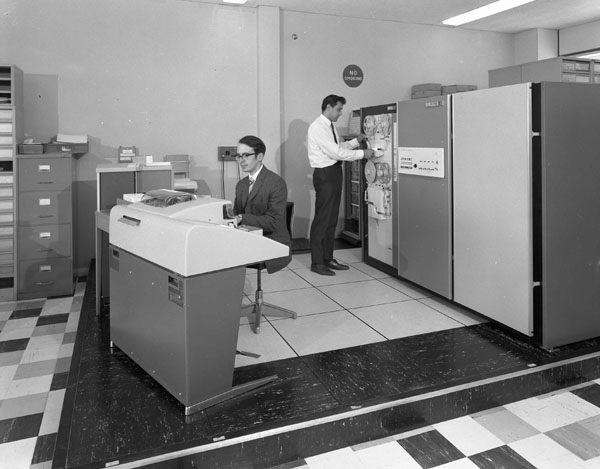
. . .
In the same tiny office, Eric's colleague, John Baldwin was doing some work for crystallographers, two of whom were squeezed behind the desk that day trying to solve a structure. These are the people who study the structure of molecules and make three-dimensional diagrams of different substances. their work is important in many fields of physics, chemistry and biology.
The mathematical calculations necessary to work out the relation
of different atoms are so great, so special and so complex that a
unique program for crystallographers has evolved, of which John
Baldwin has written a version for Atlas. It is a bit of a mixture
really
, he disclaimed. The idea was to collect all the existing
programs and make them available on Atlas
.
Originally developed in the United States at the University of
Maryland by a man named Jim Stewart, the program - X-Ray 63 -
includes a series of sub-systems with names like ORFLS (for Oak
Ridge Full Matrix Least Squares). First of all John Baldwin had to
take the American programs and rewrite them in a form of Fortran
and machine code compatible with Atlas (there is a lot of machine
code in his program because, again, it is more flexible and efficient).
There were difficulties: the American computer didn't mind an
impossibility like dividing by zero, for instance, while Atlas did.
The machine grinds to a halt and says you are trying to calculate
something that is infinite and we can't do that for you
, explained
John in that friendly anthropomorphic way that computer
programmers talk about computers. this sort of technicality had to be
written around and the language's efficiency improved at every step.
In a system where just one cycle of operations take 25 minutes' computing time,
efficiency can be important. the original X-Ray 63
system took up thirty trays of binary cards (60,000 cards).
He has got it down to five trays.
Another job John has done for the crystallographers is to develop a supervisory program for X-Ray 63 which organizes its work into separate chapters (i.e. sub-routines which are put into the computer store from tape at the beginning of the exercise). Users can then enter the system at whatever point they need and run off a chapter at a time. First the user must write his raw data on tape (chapter 1). Then, he, says, in effect, I think the atoms are in the following position, please calculate what my data should be if they are in that position (chapter 2); he may then do a refinement of these calculations to get nearer and nearer to the correct structure. then (chapter 3), he fits the basic atomic parameters (various possible positions of the atoms) to the observed data. Finally he does another chapter to work out how far the atoms are from each other and gets a print-out in the form of a lovely three-dimensional graph plotted automatically from a tape fed into a graph plotter by the computer. The number of man-years this would have taken without Atlas is prohibitive.
John Baldwin was also working on programs for the new satellite computer and disc file system, helping various users with their problems and also doing bits of mathematical research on his own hook. Over lunch, Eric, Steve Watkin - a visiting American PhD - and John talked shop in the Rutherford lab's light and airy restaurant (it looks a little like a Hollywood drive-in from the outside, but is wonderfully spacious and attractive within).
. . .
Over coffee in the common room, we talked about ringing changes - on church bells. This is a logical enough hobby for a mathematician/computer programmer since musical rules are eminently suited to mathematical analysis. Other kinds of music are also high on the list of Atlas relaxations, with lunch-time chamber music and the like. But so far they have refrained from using Atlas for musical composition - something American programmers are fond of doing.
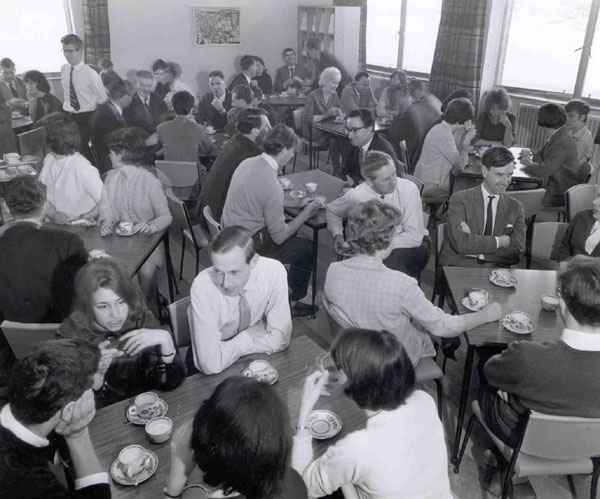
. . .
Atlas has the largest computer-operating department in the country. Like all the others it is divided into two functions, data preparation and computer room. These two functions are surprisingly separate and even at the classless Atlas lab the girls at the punch machines are somehow a bit apart - perhaps because they are all girls, and a rather good looking group too.
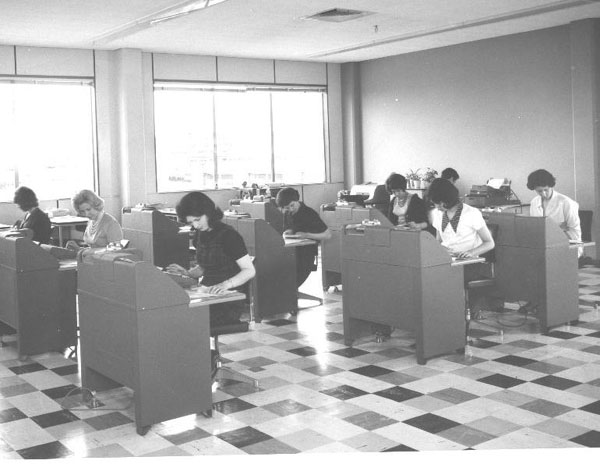
This is the department where the raw data are either punched on to cards with holes corresponding to the coded programs or on to tape through a typewriter that automatically punches holes in a paper tape. Atlas will take cards, seven-hole tape or five-hole tape, so the data prep room consists of five card punch machines, four verifiers, three flexowriters (which make seven-hole paper tapes from typewritten characters) and one five-hole tape punch - all for the staff to operate one side of the room; and across the aisle, three card punches, three flexowriters, and one five-hole punch for the users themselves to run. Twenty-four girls are employed, under the supervision of Dorothy Phelps, an attractive blonde. Most of them are on the data prep machines, a couple are on postal reception and some work with machine reception and change magnetic tapes.
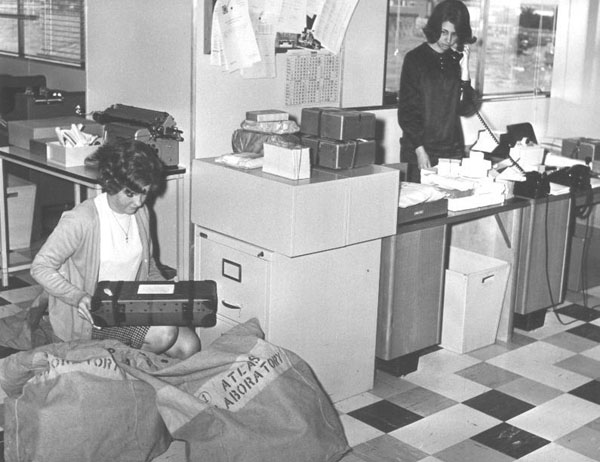
Although the machine work is fairly routine, the data prep room at Atlas is a far cry from its dim ancestor, the typing pool. The girls have no special qualifications - they are an O-level sort of group - but the qualities they are chosen for are, above all, flexibility and stamina. Dorothy Phelps finds that the greatest handicap to working at the required level of efficiency is moodiness. Girls with moods cannot keep up the pace or be agreeable to the users - sometimes a bit of tact is necessary when a punch card operator has to tell a highly qualified academic that his program will not punch up correctly, or has overrun its allotted time.
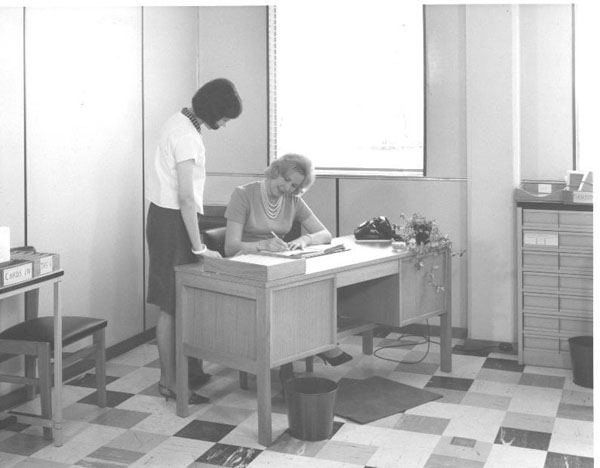
The team works in a large, light room with plenty of space and
colours. They are encouraged to learn more about the work they are
doing, to know a little about programming and to attend the lectures
given by the resident and visiting scientists. the case of Dorothy
herself is typical of the kind of thing that happens to computer girls.
She worked on tabulators for the Air Ministry, but after she switched
to the computer decided to go to night school; she found it relaxing
and has since done a two-year English course to help in writing reports.
She is married to a Civil service accountant, who can't
understand computers; he likes beautifully worked ledgers
.
Most of the girls come in young: 16, 17, 18 years old; but there are
always one or two more experienced women with the grade of Senior
Machine Operator about the place. One such was Joyce Allenby,
who was verifying a huge stack of cards which had somehow got out of
order, standing by the verifier in her stockinged feet. that day Joyce
had been dashing from machine to telephone to graph plotter
and her hot feet enjoyed the cool floor. She was supervising the
girl at the graph plotter who was keeping an eye on the automatic
pen which was writing away eerily. I know where it comes from but
not much else
, she admitted; but she also knows what it would look
like if it went wrong and then how to cope.
The machine crew, working behind a large glass wall in a room full of the machines which actually put the programs into the computer or spew them out, consist of eight people, men and girls. they are a shift leader, a deputy leader and six others who go back and forth between card readers, tape readers, magnetic tapes, teleprinters, output printers and the centre of the operations, a television monitor showing on closed circuit what the console in the computer room downstairs looks like.
Half the crew are graded as machine operators who have at least one or two O-levels, but no particular academic qualifications. the other half are scientific assistants who have a minimum of four O-levels and probably some A-levels. After they have operated the machine for two years they often make programmers; they are encouraged to learn programming anyhow because it makes them better operators. they notice errors, notice that if a job is thrown out as illegal, it may not be the fault of the program. They often go to part-time courses, day-release and night or day courses (if they work nights they get the night off before the class, but not after). when they learn, say, to solve the angles of a triangle, they can spend the odd ten seconds while the machine is quiet on their own problems.
The Operations administrators, among them Deputy head
Douggie House, admit that the salaries are pretty poor by commercial
standards, but the staff turnover varies in fits and starts, depending
more on the outside market than on anything Atlas can do. Still
the administrators are constantly working on ways to make the work
more agreeable. they study the problems of shift workers and
campaign for social changes that would benefit them - like more
flexible shop hours and longer TV broadcasts. At the same time,
they are not pushing shift work too far. I think people are neurotic
about computers. They try to get as much work as possible out of
them - a steel company can switch off at lunch, why not a computer
is the way Mr House put it. One way they adapt is to put on
all the long programs at night so that when metabolism is low,
activity can be relatively low too. Meanwhile the computer
downstairs does its ten- or twenty-minute jobs.